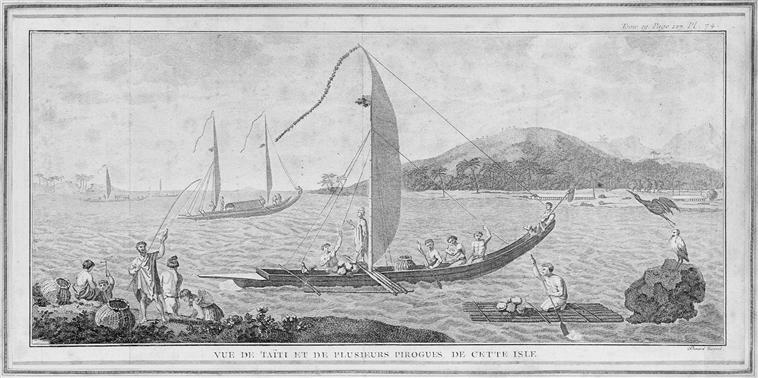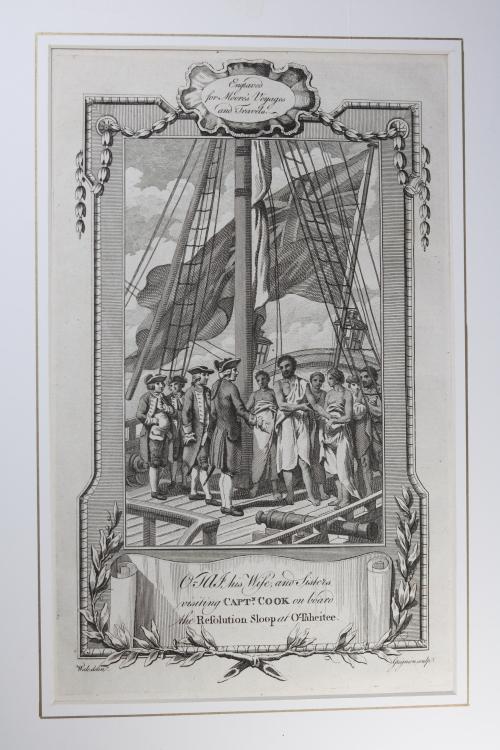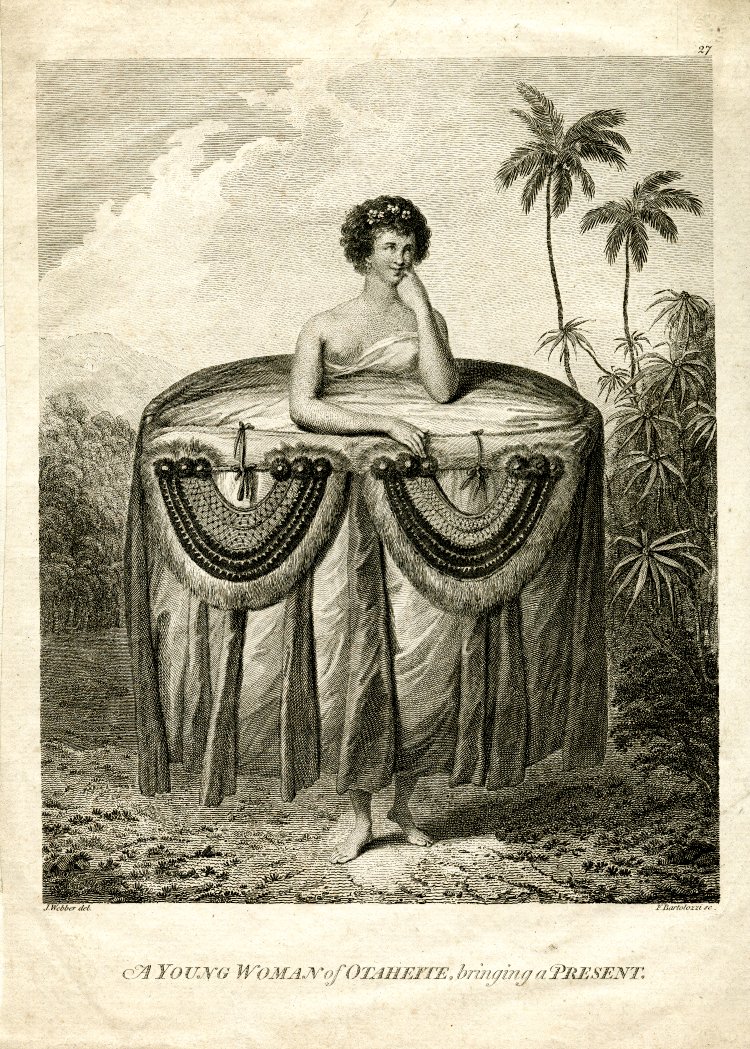This article is an adaptation of our conference De la Vahiné à Vaiana : mythologies européennes de l'Océanie, des Lumières de la philosophie à celles des projecteurs, which was held at the École du Louvre on 27 March 2019, as part of our partnership with the Bureau Des Élèves de l'École du Louvre for the "Mythes et Légendes" gala.
White sandy beaches, turquoise waters and vahines: these are the few images that come to mind for many of us when we think of Oceania. If the paradisiacal landscapes do exist, what about those famous vahines? Eternally accompanied by her ukulele, following the steps of a lascivious dance... the Polynesian woman as seen in the popular imagination seems to give a foretaste of paradise.
This woman, who exists in a corner of all our European imaginations, is above all the image of the "super-woman", a sort of perfect woman... At least from a male point of view! Very beautiful, very lightly dressed, seductive, warm: this figure has become, over time, the Polynesian welcome figure, present at the exit of the planes to decorate the happy tourist with necklaces of flowers and many smiles.
The vahine, if she exists in the literal sense of "woman" - since this is the meaning of the word "vahine" in Polynesian languages, with different derivatives: fafine in Samoa, wahine in Hawaii, etc. - has been the object of so many fantasies, and the subject of so many legends, that she has taken her place in the pantheon of mythical figures in our popular culture.1 The imagination associated with it still has a great influence on our perception of the Pacific and its cultures, and it is therefore necessary to question the origins and creation of this myth.
To do this, we need to look at eighteenth-century Europe, and more particularly at the period of the Enlightenment in France. Europe did not wait for this century to confront otherness or to begin its territorial expansion, with all the ills that we know: encounters with Asia, Africa and the Americas had already allowed Europe to question the nature of man, to define some as 'savages' and others as 'civilised'. From the dawn of the Enlightenment, the questions raised by these new discoveries were used to define a 'natural history of man', even if it meant rejecting the dogma of Christian Genesis.2 The question of the naturalness of man was constantly debated in the 18th century, and these questions were to play an increasingly important role in the intellectual life of the century to come. If maritime expeditions and their share of discoveries for Europeans fed these questions about natural man, the reverse is also true: philosophical questions about the nature of man also fed the ambitions of 18th century travellers. But we would of course be far from the truth if we imagined European explorers to be in search of a philosophical grail: the navigators who set out to discover the Pacific in the 18th century were primarily motivated by commercial and political interests. One of these expeditions, however, was to become one of the most important for the Philosophers of the 18th century: that of Louis-Antoine de Bougainville, the first Frenchman to circumnavigate the globe, between 1766 and 1769. Although Bougainville's primary aim in exploring the South Pacific was to discover new lands for France and to strengthen the kingdom's commercial interests, his luggage certainly included Jean-Jacques Rousseau's Discourse on the Origin and Foundations of Inequality among Men, Buffon's Natural History and the works of Court de Gébelin, who set out to trace the first human language.
![Vuë_de_la_Nouvelle_Cythère_[...]_btv1b550047786_1](https://casoar.org/wp-content/uploads/2019/06/Vuë_de_la_Nouvelle_Cythère_..._btv1b550047786_1.jpeg)
View of New Kythera discovered by Mr de Bougainville commanding the royal frigate the Boudeuse and la Flûte l'Étoile, 1768, source: https://gallica.bnf.fr/ark:/12148/btv1b550047786
On the morning of 2 April 1768, the crew discovered an island that alone justified the voyage... Quickly named New Kythera or Garden of Eden by Bougainville, it was in fact an island that we know as Tahiti, and which became the explorer's most famous "discovery", even though the crew had only spent ten days there in all. The arrival on this island as described by Bougainville in his journal is the origin of all our legends linked to the Vahiné and to Polynesian customs in a more general way. The facts, as recounted by Bougainville in his Voyage autour du monde in 1771, leave one wondering:
"As we approached the land, the islanders surrounded the ships. The crowd of dugout canoes was so great around the ships that we had great difficulty in mooring in the midst of the crowd and the noise. Everyone came shouting "Tayo", which means "friend", and giving us a thousand tokens of friendship, all asking for nails and earrings. The dugouts were full of women who, for the beauty of the face, do not yield to the greatest number of Europeans, and who, for the beauty of the body, could compete with them all with advantage. Most of these nymphs were naked, for the men and old women who accompanied them had taken off the loincloths with which they usually wrap themselves. They first made us some teasing from their dugouts, in which, in spite of their naivety, we discovered some embarrassment, either because nature has everywhere embellished the sex with an ingenuous shyness, or because, even in countries where the frankness of the golden age still reigns, women do not seem to want what they most desire. The men, who were simpler or freer, soon made themselves clear: they urged us to choose a woman, to follow her ashore, and their unequivocal gestures demonstrated the way in which we should deal with her. I ask you: how can you keep four hundred young Frenchmen, sailors, who have not seen a woman for six months, at work in the middle of such a spectacle?"
A welcoming island, a friendly people, and above all, women offered... and not just any women, because one element is very important in the creation of these legends around the vahine: the women of Polynesia have white skin. They were contrasted with the people they met in Australia, with black skin, defined as "hideous" by the Europeans, since they were so different from themselves... This dichotomy between a white Oceania and a black Oceania defined, for the European of the time, the difference between the "good savage" and the "bad savage", with on one side the white Polynesian in an aristocratic society, whose rules could remind those of the Europe of the 18th century, and on the other side of the chessboard, black peoples, whose very diverse societies and languages were for the Western traveller the unmistakable sign of an intellectual inferiority.
On his return to France, Bougainville published his Voyage autour du monde in 1771. In it, he made much room for the welcome Tahiti had given him and his men and wrote, for example:
"Every day our people walked around the country. They were invited into the houses, and given food; but the civility of the masters of the houses here was not limited to a light snack; they offered them young girls."
Bougainville describes the ritual associated with this "cult of Venus", or how the whole village threw foliage and flowers on the ground, played music and encouraged the carnal act, while witnessing it: the Tahitians "breathe only the pleasure of the senses", to use Bougainville's phrase. The dances he saw on the island were described as lascivious and reminiscent of "the sweetness of love". The French quickly concluded that Tahitian customs included sexual hospitality and public sex acts. They saw a free people, devoid of any sense of shame or jealousy, carefree and concerned only with their pleasures. "Here is the only country that has given me a taste for a country other than my own," Bougainville wrote.

View of Tahiti and several pirogues from this island, late 18th century, print, Musée du Quai Branly. Source : https://www.photo.rmn.fr/archive/78-001942-2C6NU0XQJC7U.html
The explorer's work quickly became the talk of Parisian salons, and Bougainville's voyage was the subject of a philosophical commentary by Diderot in 1773: the Supplément au voyage de Bougainville. In it, the Tahitian society is defined as a childlike society, knowing no other laws than its instinct and nature, while Europe is seen as a decrepit old man, whose social norms, too numerous, too constraining, are ridiculed in the face of the simple and good life led by the Tahitians.
Less than a year after Bougainville's passage, it was James Cook's turn to venture to the Tahitian coast in 1769; he returned on his second voyage in 1773, then in 1774, and finally on his third and final voyage in 1777. He described the same 'conviviality' as Bougainville. The engraving below shows a Tahitian chief offering his sisters to Cook's crew. This scene of women being offered hospitality was repeated during the first contact in Hawaii in 1778: the whole of Polynesia was then seen as a land of carefree fun.

O-Tai, his wife and Sisters visiting Captn Cook on board the Resolution Sloop at O’Taheitee, Charles Grignion d’après Samuel Wale, 1778. Source : https://chadbourneantique.com/products/print-o-tai-his-wife-and-sisters-visiting-captn-cook-on-board-the-resolution-sloop-at-otaheitee-1778
As Cook had taken painters on board his ship, Europe was able to discover the famous paradise described by the sailors, and the famous "nymphs" of which the sailors had spoken so much: the first images of the vahine thus reached Europe. The drawings made on the spot by the artists who sailed with Cook found a strong echo on their return to Europe with artists who reinterpreted these vahine, giving them an antique look, as here with the bare breast, which did not appear in Webber's original version.

A young woman of Otaheite, bringing a present, 1780/85, gravure d’après John Webber. Source : https://www.britishmuseum.org/research/collection_online/collection_object_details.aspx?objectId=3186857&partId=1
The so-called lascivious dances are also represented3, and contribute to spreading the image of a Polynesian woman entirely devoted to seduction in the engravings made in Europe.
If these images of a paradisiacal Tahiti and a Polynesia entirely devoted to the games of love are certainly very seductive, let us not forget to consider them for what they really are: myths. For, despite the sweet dreamers, the truth seems quite different, in the light of what we now know about Polynesian societies.
This misunderstanding is initially explained by an important event that occurred shortly before Bougainville's arrival. Contrary to what he thought, he was not the first European to land on the Tahitian coast: a few months before him, the English navigator Samuel Wallis passed by, and his encounter with the islanders was much less peaceful: a series of misunderstandings led to the attack of the English ships by the Tahitians, who retaliated with guns and then with cannon. The Tahitians finally negotiated peace, and it is in this context that Bougainville's arrival should be placed.

The natives of Otaheite, attacking Capt Wallis, the first discoverer of that island, d’après la gravure de John Hawkesworth publiée en 1773 ; entre 1767 et 1850. Source : https://www.netfenua.pf/natifs-de-otaheite-attaquant-le-capitaine-wallis/
As for the sexual misunderstanding, it is tragic: one can easily imagine, unfortunately, that a ship populated by exclusively male individuals, who had not made a stopover for months, were only too happy to pounce on the bargain offered to them by these young women brought to them, to think of understanding what was really going on around them. Nevertheless, two important things can be noted in the travellers' accounts: the Tahitian women presented were all very young. Married women were never offered. And finally, the young girls said to be "offered" were indeed offered... by others. They were always brought by other people, chiefs or elderly people. In reality, these girls were only obeying the orders of their leaders. They were not offering themselves, they were being offered, and that is the huge difference... Every navigator had noted how they were pressed to take the girls quickly, and how a ritual accompanied the sexual act. The Europeans, convinced that they were being welcomed as distinguished guests, too busy enjoying what was on offer, failed to notice a series of details: in Hawaii, an islander points to the sun, asking if the travellers were from there, each European is examined meticulously... These details, combined with other accounts of travel to other Polynesian archipelagos, make it possible to state with almost certainty that Europeans were not seen as humans, but as spirits, or gods.4 From then on, it was a matter of pleasing these superhuman beings, in order to attract their benevolence, and of capturing some of their divine essence, by encouraging young girls to become pregnant. In a society for which only the first-born possesses the strength of the parents, it was therefore necessary to present only young girls who were still childless, so that the infant would possess the divine essence of these visitors. This explains the very young age of the Tahitian girls offered to the sailors, as well as their attendants, forcing their hands, stripping them naked in front of the crew, and even the tears noticed on the cheeks of certain Tahitian girls.
Thus began one of the first great misunderstandings between Europeans and Polynesians, leaving its mark on our beliefs to this day, transforming terrified young girls into nymphs of love, on a New Kythira whose taste is undoubtedly a little more bitter to those who are no longer ignorant of its underbelly...
Camille Graindorge
Cover picture: A dance in Otaheite, J.K. Sherwin d’après Webber, 1785.
https://www.google.com/url?sa=i&rct=j&q=&esrc=s&source=images&cd=&ved=2ahUKEwiBy5PHz-LiAhWi8uAKHRbRAhkQjxx6BAgBEAI&url=https%3A%2F%2Fwww.britishmuseum.org%2Fresearch%2Fcollection_online%2Fcollection_object_details.aspx%3FobjectId%3D3188375%26partId%3D1&psig=AOvVaw3-e9IX_mNAE6x-xop0Ssb_&ust=1560383472898207
1 See BOULAY, R., 2000. Kannibals et Vahinés. Imagerie des Mers du Sud. La Tour d’Aigues, Editions de l’Aube.
2 For the second half of the 17th century, see Hobbes' pessimist vision in Le Léviathan, 1651, from which the famous phrase "Man is a wolf to man" is taken.
3 See cover picturee A dance in Otaheite, J.K. Sherwin after Webber, 1785, source:
https://www.google.com/url
sa=i&rct=j&q=&esrc=s&source=images&cd=&ved=2ahUKEwiBy5PHz-LiAhWi8uAKHRbRAhkQjxx6BAgBEAI&url=https%3A%2F%2Fwww.britishmuseum.org%2Fresearch%2Fcollection_online%2Fcollection_object_details.aspx%3FobjectId%3D3188375%26partId%3D1&psig=AOvVaw3-e9IX_mNAE6x-xop0Ssb_&ust=1560383472898207
4 This theory is developped by Marshall Sahlins, « Supplément au voyage de Cook », chapitre 1 de SAHLINS, M., 1989. Des îles dans l’histoire. Paris, Seuil / Gallimard/ Ed. De l’EHESS, p.24. Or in SAHLINS, M., 1995. How « Natives » think ? About Captain Cook for example. Chicago, The University of Chicago Press. All the history of these sexual misunderstandings are studied in TCHERKÉZOFF, S., 2004. Tahiti – 1768. Jeunes filles en pleurs. La face cachée des premiers contacts et la naissance du mythe occidental. Papeete, Au Vent des Îles.
Bibliography:
-
BOULAY, R., 2000. Kannibals et Vahinés. Imagerie des Mers du Sud. La Tour d’Aigues, Editions de l’Aube.
-
DIDEROT, D., 2011 [1773]. Supplément au voyage de Bougainville. Paris, Gallimard.
-
SAHLINS, M., 1995. How « Natives » think ? About Captain Cook for example. Chicago, The University of Chicago Press.
-
TCHERKEZOFF S., 2004. Tahiti – 1768. Jeunes filles en pleurs. La face cachée des premiers contacts et la naissance du mythe occidental. Papeete, Au Vent des Îles.
- VIBART, E., 1987. Tahiti, Naissance d’un paradis au siècle des Lumières. Bruxelles, Complexe.
